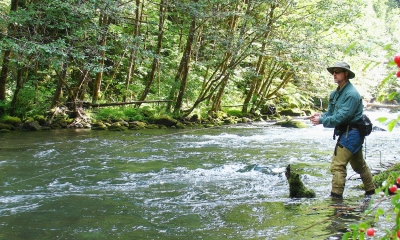Fishing during blue-green algae (cyanobacterial) blooms
As temperatures heat up during spring and summer, be on the watch for harmful algae blooms when recreating in Oregon lakes, rivers and reservoirs. Here’s what anglers should know.
The following information comes from the Oregon Health Authority.
What anglers need to know
Cyanobacteria (also known as blue-green aglae) are microscopic organisms that grow naturally in all waters. Under certain conditions, cyanobacteria can grow into a large visible mass called a bloom. Cyanobacteria grow in fresh waters and can produce toxins that may cause harm to humans and animals. This information is presented in response to questions often asked by people who plan to fish in waters affected by a cyanobacterial bloom.
Is it safe to eat fish caught from waters affected by a cyanobacterial bloom?
Eating fish caught from affected waters is an unknown health risk. There have been no reports of people becoming sick from eating fish caught during a bloom, but there has been no definitive research regarding the risk to human health.
It is known that some cyanobacterial toxins (called cyanotoxins) have been found to accumulate in fish tissues, and particularly in the internal organs such as the liver and kidneys. Toxin accumulation studies suggest that the muscle (fillet) tissue is less affected by cyanotoxins.
I’ve decided I want to eat the fish. Are there precautions I should take?
If you decide to eat fish caught from waters affected by a cyanobacterial bloom, remove the fat, skin and organs before cooking. Be careful not to cut into the organs. Before cooking or freezing the fish, rinse the fillets with clean water to remove any contaminants from the cleaning process.
What if I decide to leave the skin on when cooking or smoking the fish and remove it later?
Removing the skin is standard public health advice regarding safe fish consumption and is a normal part of cleaning fish. However, there is no documentation that the skin poses an increased risk of exposure to cyanotoxins, or that leaving the skin on during cooking or smoking increases the health risk.
Is there a limit on how any fish I can safely eat?
It is advisable to use moderation when eating fish from waters affected by a cyanobacterial bloom. One or two fish meals per week is the usual recommended limit.
Eating more than one or two meals of fish contaminated with cyanotoxins per week over an extended period of time could cause liver or neurological damage, but that is unlikely given the low amount of toxins in fillets and how often people eat fish.
What are the health effects of eating fish caught during a bloom?
There have been no reports of people getting sick from eating fish caught during a bloom, but the scientific study in this area is incomplete. The Oregon Public Health Division recommends a precautionary approach of limiting consumption of these fish.
Are there any fish that are of more or less concern?
- Never eat freshwater clams from affected waters.
- Crayfish muscle can be eaten, but internal organs and liquid fat should be discarded.
- Anadromous fish, such as salmon and steelhead that migrate from salt waters into fresh waters affected by a bloom have very little opportunity to concentrate much toxin. They are less likely to be contaminated than fish that spend their entire lives in freshwater, such as rainbow trout.
Are there other precautions I should take while fishing?
- Avoid direct skin contact with water affected by an algae bloom.
- Wear protective gloves or wash your hands thoroughly with clean water when you are done fishing.
How long after a public health advisory is lifted do I need to wait before fishing?
There is inadequate evidence of hazardous toxin accumulation in fish fillets, thus there is no recommended waiting period during or after a cyanobacterial bloom.
Symptoms of cyanobacteria exposure
Exposure to cyanobacteria can be serious and result in a range of symptoms including skin rash, diarrhea, cramps, vomiting, numbness, dizziness and fainting. Children, people with weakened immune systems and pets are most vulnerable to illness.
Pets are at risk, too
In the past, we’ve had reports of dog deaths due to exposure to bloom-affected water. The Oregon Public Health Division and Douglas County Health Department conducted specific outreach efforts along the South Umpqua River and mainstem Umpqua River following widespread publicity of dog deaths in the area. The concern triggered by this event has increased awareness among pet owners who are taking additional action to protect their pets.
When to avoid water contact
Because only a fraction of Oregon’s fresh waters are monitored, the public can’t count on being notified about all harmful algae blooms, so there are certain conditions you can identify to stay safe and healthy. If the water smells bad or looks foamy, scummy, thick like paint and pea-green, blue-green or brownish-red in color, it’s best to stay out.

